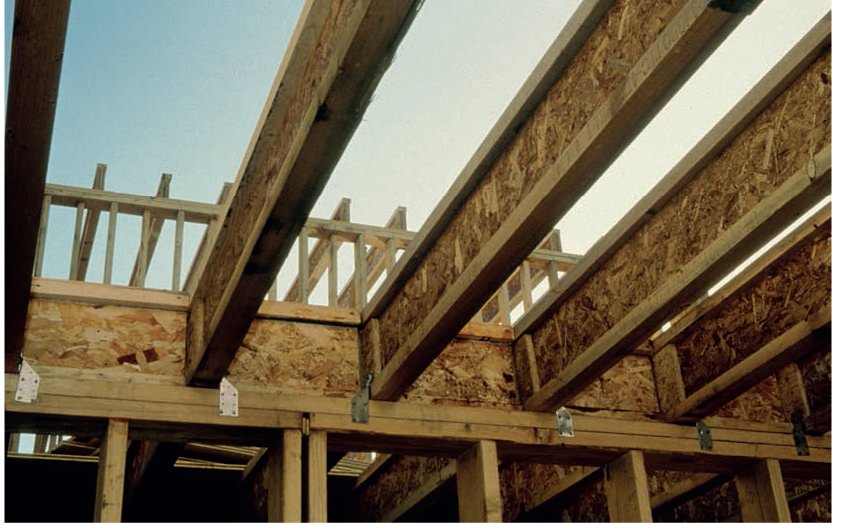With increasing numbers of non-traditional households – including singles and single parents – limited, conventionally designed housing layouts no longer suit the needs of all potential occupants. In addition, an increasingly elderly population has created a demand for dwellings that can be adapted to the evolving lives of their occupants without requiring costly and intensive alterations (Palmer and Ward 2010).
Adaptable units accommodate varying spatial needs and facilitate the introduction of new building systems without compromising functionality or comfort. These homes use design concepts and technologies to create an environment in which modifying the building is preferable and more readily achievable than moving to a new location or demolition. While fully adaptable houses include aging in place and expandable homes principles, this chapter only focuses on adaptability.
For a house to be adaptable, it is important to design layouts that can be flexible to the needs of the household as it changes. This involves macro considerations, such as the design of the overall structure to provide adaptable interiors, and micro considerations, like the positioning of doors and wet functions (kitchens and bathrooms).
One way to have a flexible layout is to design a structure that requires little or no internal load-bearing support (Friedman 2002). This can be done either by designing a narrow house with floor joists that span the entire space between the two exterior longitudinal walls or by using products such as I- or open-web wooden joists, which allow greater spanning distances. Creating large, open floor spaces permits maximum adaptability.
If the structure does require internal supports, it is important to place them adjacent to permanent functions, such as the bathroom and the kitchen, which are unlikely to be moved. Wet functions, however, which are difficult and expensive to relocate, should be grouped together and placed between zones.
Once a large, uninterrupted floor has been constructed, the space itself must also be arranged for maximum adaptability; creating an open floor plan with multipurpose uses can achieve this. A successful multipurpose space can be designed with dimensions and proportions to accommodate a variety of activities such as sleeping, sitting or working. These spaces need to be as large and as square as possible to expand adaptability options. Room sizes of 3.7 by 3.7 m (12 by 12 ft) up to 4.6 by 4.6 m (15 by 15 ft) should be sufficient to accommodate any future adaptations (Friedman 2002). In addition, it is important that these multipurpose spaces contain no defining features, like closets, which tend to limit their overall adaptability.
Figure 5.1 The use of I-joists as structural members allows for greater spanning distances, which eliminates the need for loadbearing walls and offers interior adaptability.
For each of these multipurpose spaces, the placement of doors should be made to allow further adaptability. Doors located near the corners of a room, for example, permit the space to be divided in two because another door can easily be added elsewhere when needed. This arrangement also increases efficiency because it does not interrupt circulation. Furthermore, if the door is placed in the corner it makes more sense to leave a small gap for shallow storage along the wall behind it.
Another consideration of adaptable design is creating housing with effective integrative circulation. Initially, this means avoiding building in paths that pass through the middle of spaces, which tends to designate them as public and prevents their future conversion into private rooms without considerable alterations. Creating an independent path that feeds into the living spaces is the best option. These can be located either along a wall, or in a central place from which other multipurpose spaces are reached. It is also important that these paths are treated as multifunctional spaces, in order to increase their efficiency and ultimately their potential adaptability. This can involve widening halls and incorporating features such as temporary storage along their walls. If an extension is built in future, these storage areas can easily and affordably be removed and replaced with stairs. Positioning stairs as a wedge facing the middle of a floor should be avoided since it creates a large central space that cannot be used or adapted easily.
After such decisions have been made, residual spaces might be left. These consist of areas under the stairs, or the small alcoves in bay windows or corridors, which are good locations for storage and allow for greater adaptability within the larger areas.
Beyond circulation and flexible layouts, the use of adaptable utilities or service modules is another way to increase adaptability. This involves using items such as movable kitchen cabinets, or modular furniture components, which can easily be rearranged. It is also possible to use furniture for the division of spaces; storage, such as shelves, can be used to distinguish different functional areas within a large room.
In parallel, designing utilities for adaptability is vital in adaptable dwellings. Plumbing, ventilation and heating systems require maintenance and updating due to technological advancements and general wear-and-tear. Therefore, it is essential that these systems be easily accessible should they malfunction or require updating. This can be done by including a vertical service shaft with accessible chases. A chase is a horizontal tube that runs in each floor and contains the essential utilities needed for that floor. A vertical service shaft may originate at the mechanical rooms and bring all conduits up to allow them to break off into sub-chases at each floor as needed. The chase could be accessible through a floor panel for easy reach by service professionals without causing major damage to existing walls or floors (Friedman 2002).
It is also possible to use an accessible feeder pipe for electrical outlets. In multipurpose spaces, outlets must be placed either along the walls or within the floor due to the fact that building regulations prohibit their placement in demountable partitions. This allows homeowners to use matrix tiles and baseboard profiles as feeder tubes for electric wires and cables, which in turn allows for greater adaptability, as computer stations and phone jacks are no longer limited by traditional wall outlets. This idea can even be extended to the kitchen, where electrical raceways can be placed along counters to allow the hook-up of appliances anywhere.

Figure 5.2Placing a door near the corner of a room and having two windows will facilitate division of that room in two.
When one recognizes the many benefits of adaptable housing, it becomes clear why such designs are starting to be accepted by the industry and governments. The Australian Government, for instance, has already specified strict codes for not only adaptable housing, but also accessible and universal housing designs (Palmer and Ward 2010).
•Rise in the number of non-traditional households
•Lack of innovatively designed interiors
•High cost of housing
•New technological advances
INNOVATIONS
•Demountable partitions
•Flexible plumbing fixtures and fittings
•Multi-purpose space design
•Thoughtful placement of doors
•Use of moveable cabinets
5.1 ADAPTABLE HOUSES |
|
Project |
Butler House |
Location |
Melbourne, Australia |
Architect |
Andrew Maynard Architects |
The Butler House is an elegant warehouse-turned-residence designed by the Australian firm Andrew Maynard Architects. The client, a household with two young boys, asked for a livable and adaptable house based on the present and future needs of each member. The original warehouse measured 44 m2 (474 sq ft), lacked sound and thermal insulation, had minimal infiltration of natural light, and lacked space and privacy.
The architect solved these challenges by removing the existing roof, and replacing it with a canopy-covered terrace. The addition of the 85 m2 (915 sq ft) terrace introduced a quality that many houses in the city lack: an outdoor private area adequate for family gatherings. A skylight floods the three floors with natural light that also ties the levels together. Adjustable louvres and timber shelves can be used as bookshelves, but also as spatially functional slides to control acoustic level and light infiltration. In the summer, a passive solar design approach protects the roof terrace from direct sunlight exposure and rain, while opened louvres allow light, sound and ventilation to travel through the house.
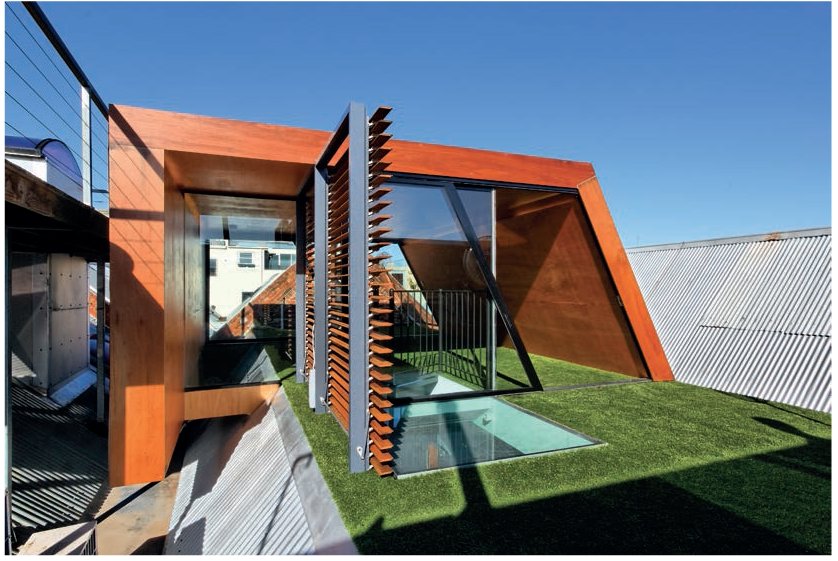
The rooftop outdoor area with the adjustable louvres.

Ground (left), second floor (middle) and upper level (right) in an open design concept.

A view of the living room from the mezzanine.
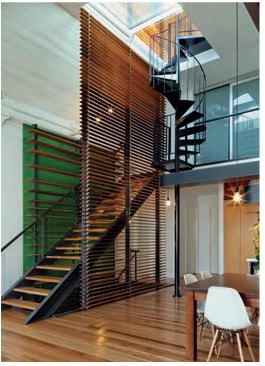
The open stair represents the adaptability of the dwelling.
The children’s rooms are located on the mezzanine. The rooms are protected by a sliding wall that offers privacy control and noise protection when needed. The strategic placement of the beds, desk and storage leaves room for additional furniture, such as a double bed, if needed for visiting family members. Similarly, on the other side of the same floor, the master bedroom also has a large sliding door. By using adjustable design features, the Butler House offers private and collective spaces for all family members and their guests.

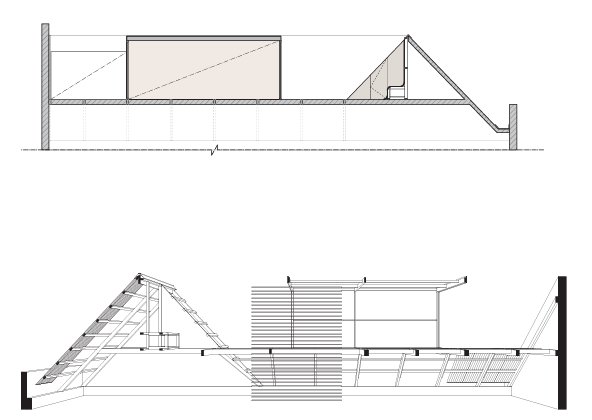
Section showing the old and the newly added roofs.
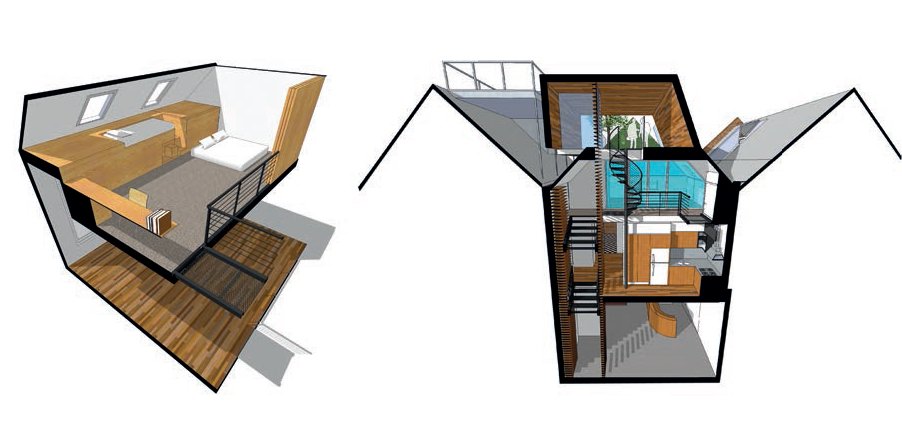
Cross sections showing all floors.
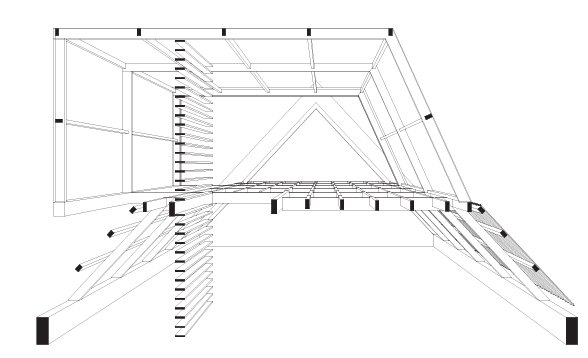
Perspective showing the roof structure.

Perspective showing the new roof addition.
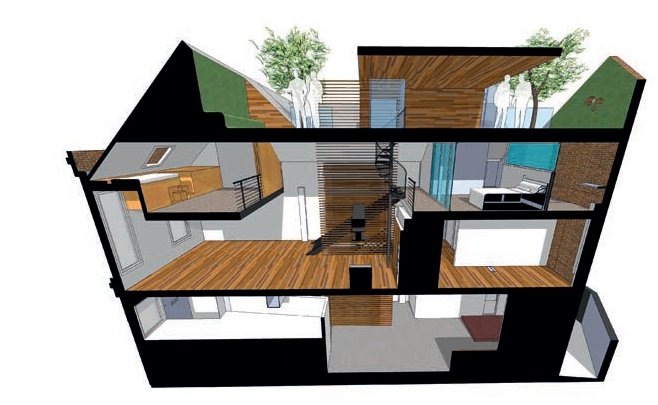
A longitudinal section illustrating the open spaces of the home.
5.2 ADAPTABLE HOUSES |
|
Project |
Live Work Home |
Location |
Syracuse, New York, USA |
Architect |
Cook + Fox Architects |
Located in Near West Side, Syracuse, New York, the firm Cook+Fox Architects took careful note of their economically deprived neighbourhood when designing the Live Work Home, looking at both its current situation and future potential. The architects’ idea was to mix residential and commercial activities in one building to generate new opportunities. The resulting home, which measures 126 m2 (1360 sq ft), is an addition to a community that is comprised of several family generations and age groups, as well as offices and workshops. At one storey tall, the house has ground-level access and its inherent construction qualities allow it to be expanded or reduced linearly within its given lot, according to the changing needs of its dwellers.
The design is driven by efficiency and the simple idea of adapting the interior layout through seven potential lifecycle stages, ranging from childhood to multigenerational living. The construction is achieved through a mix of prefabrication and on-site techniques and the materials used are designed for maximum efficiency. The unique facade has an interchangeable screen that allows the family to alter the interior according to privacy and orientation preferences.
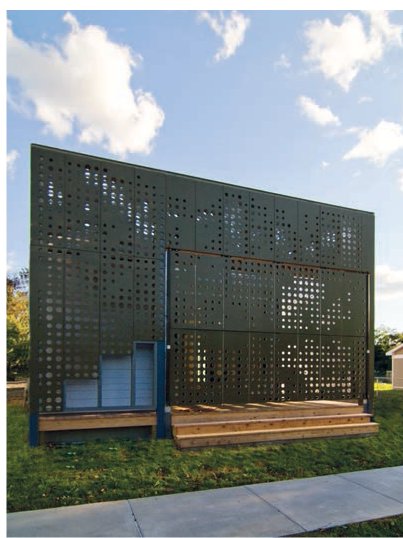
Rear facade with the screen closed (left) and open (right).

Ground floor plan (top) demonstrates the linearity of the dwelling. Site plan (bottom).

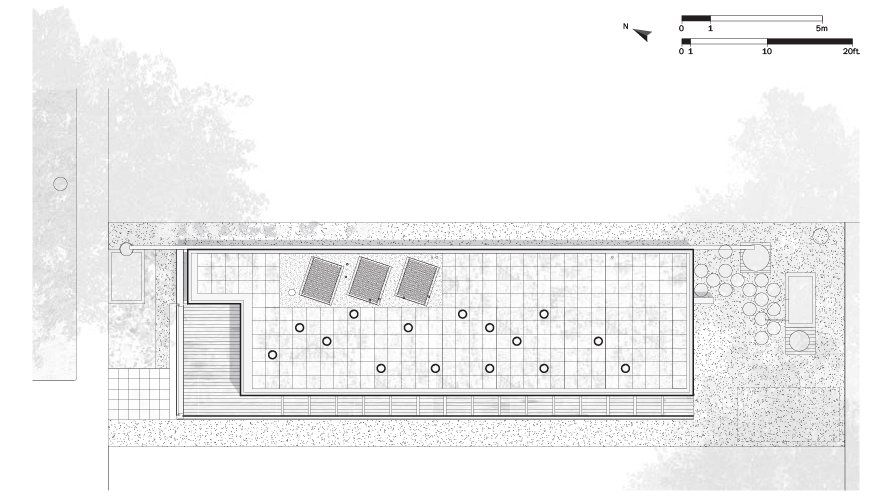
The wet areas, such as the kitchen and bathroom, are located at the core of the long plan. This allows for better accessibility for future extensions with minimal changes to the existing partitions. When the family grows, another bedroom can be added beside the existing ones. The reverse is also possible, if the family size decreases. A modular system of mobile furniture can be shifted, added to or removed to reduce unused space and meet the demands of household members. These design features are significant when contrasted with the costly renovations associated with non-adaptable units. The furniture and the prefabricated wall partitions also offer opportunities for do-it-yourself remodelling.
In an effort to achieve LEED certification, the architects employed several ‘green’ technologies when constructing the house. Energy consumption is reduced with the use of solar panels and a geothermal heating system, while the strategic north-south openings allow for cross-ventilation and also allow heat recovery ventilators (HRV) to constantly filter indoor air. Aiming to revitalize the community, Cook+Fox Architects are hopeful that the Live Work Home, used as a prototype for future building, will sustain and serve a wide range of family types and economic needs.

Rear elevation with the folded screen.

Side elevation showing point of light penetration through the roof.
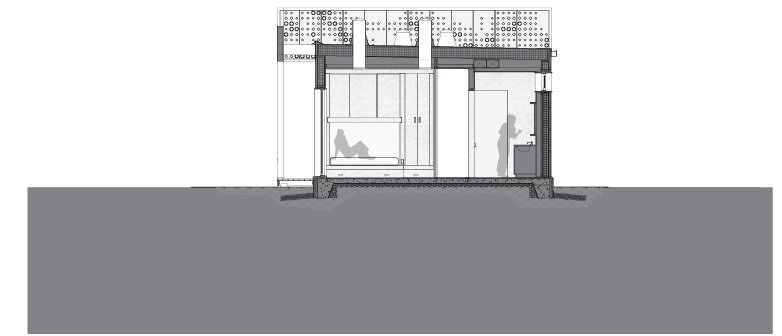
Section showing the dwelling’s rectangular shape.

Screens allow the space to be divided, but clever use of latticework prevents the areas from seeming dark.

